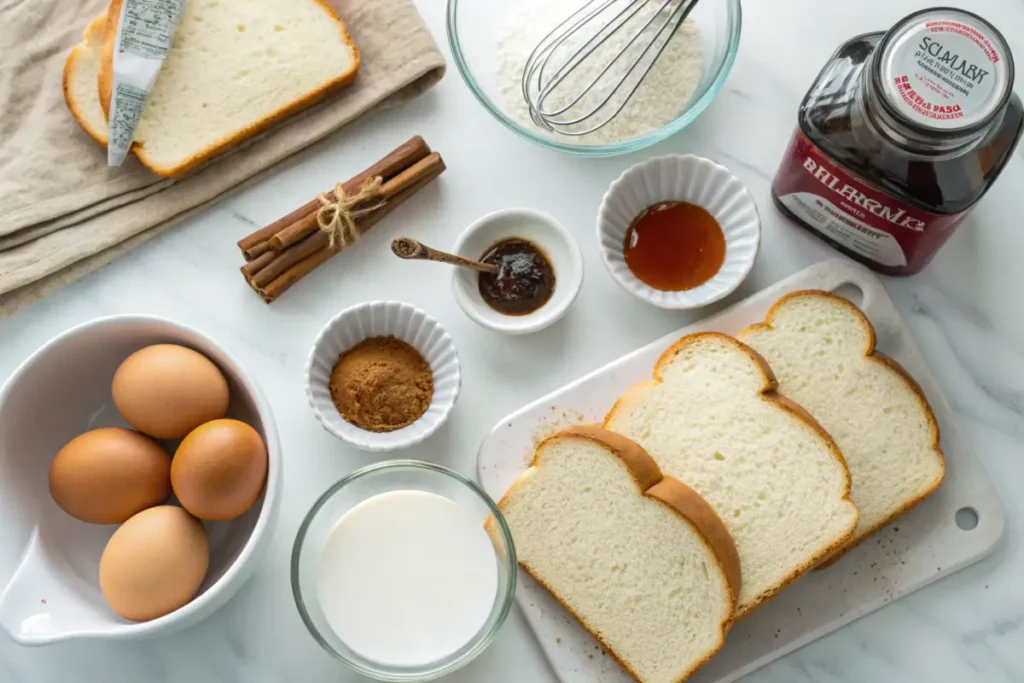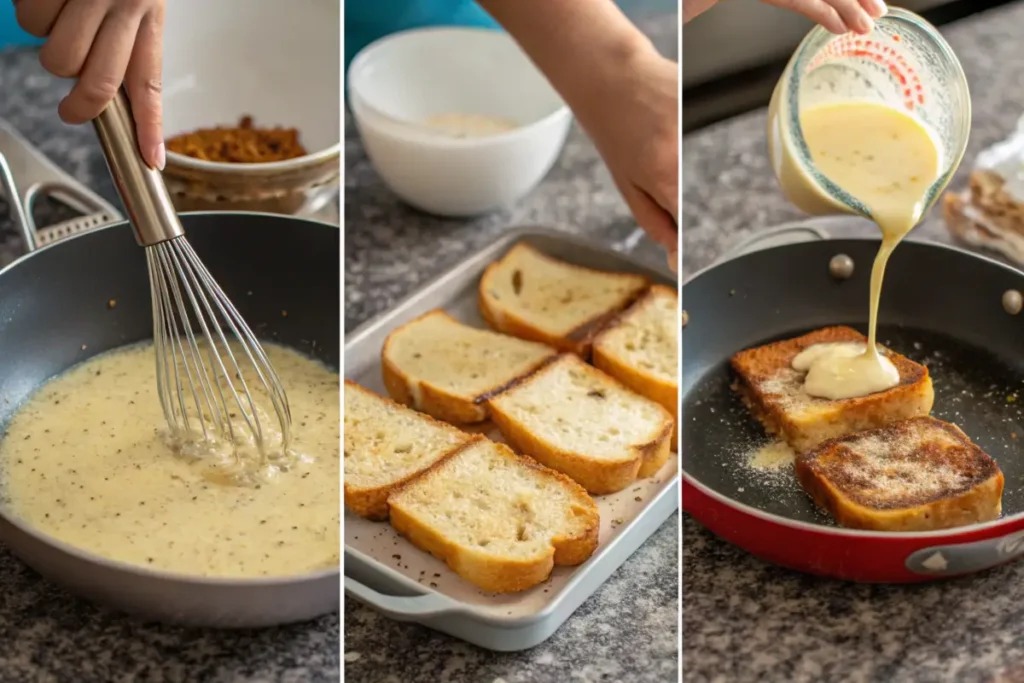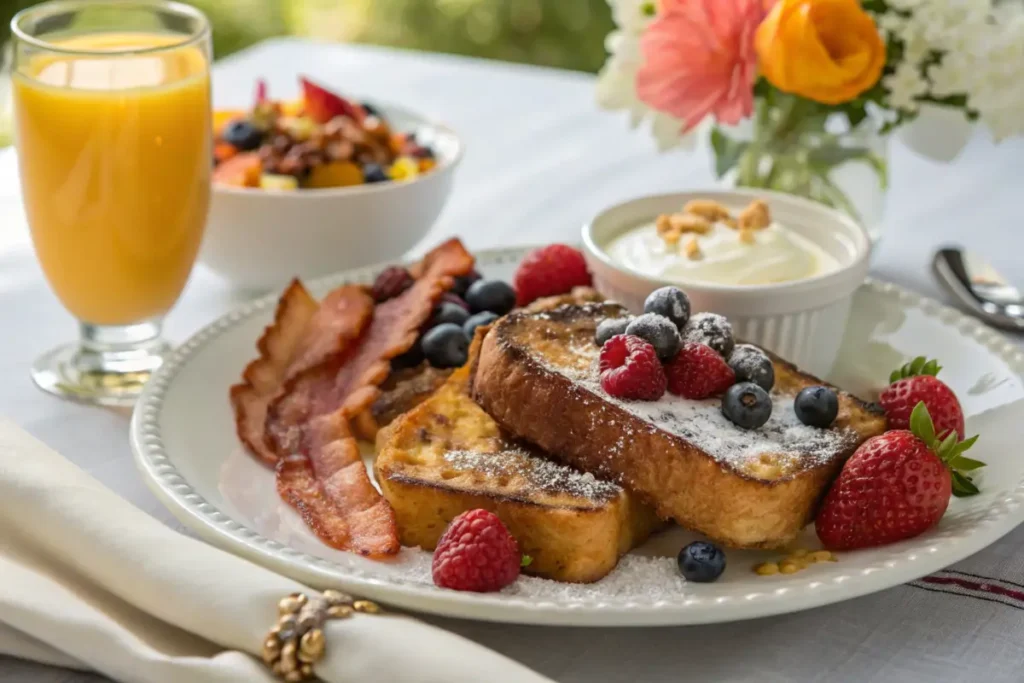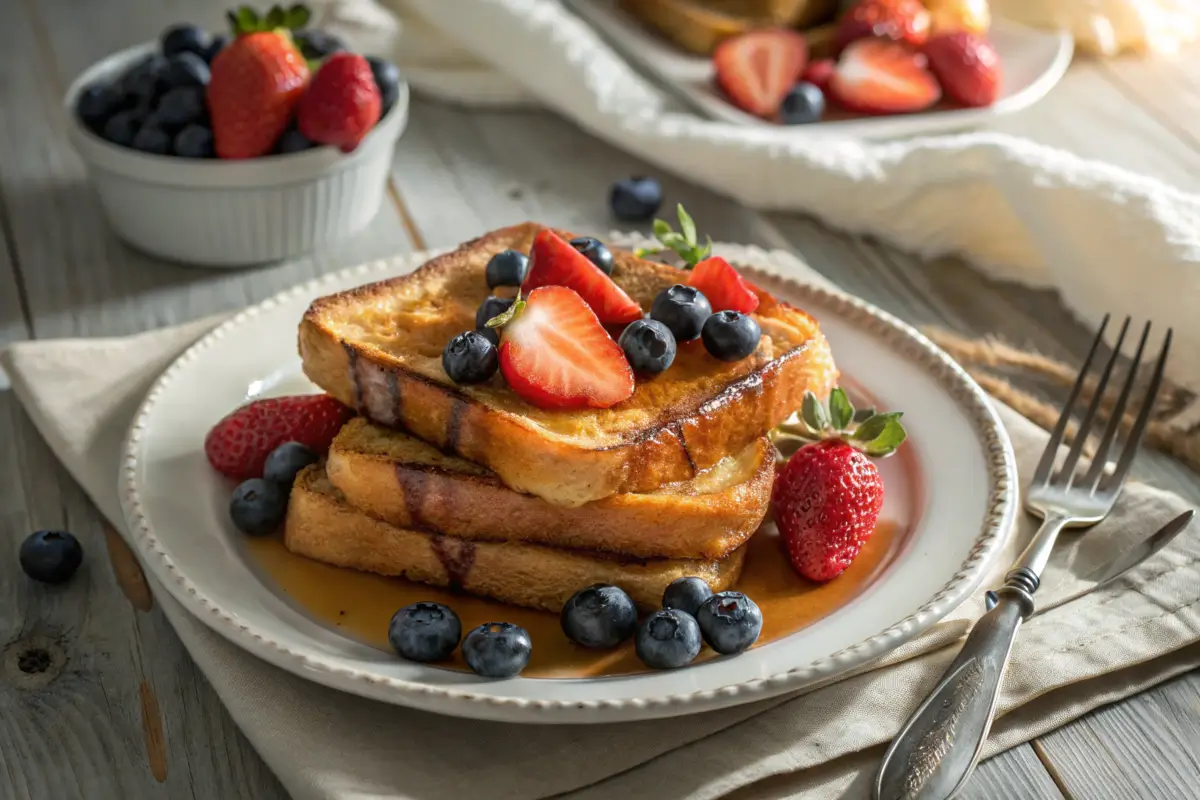French toast is a beloved breakfast classic that has stood the test of time. From its humble beginnings to its place on gourmet menus, this dish is a crowd-pleaser for all ages. McCormick French Toast, with its signature spices and flavors, elevates this dish to new heights. In this guide, we’ll dive deep into the world of French toast—its origins, McCormick’s unique twist, recipe variations, pairing ideas, and even some nutritional insights. Whether you’re a beginner or a seasoned cook, this article will help you perfect your French toast game.
Introduction to French Toast
The Origins of French Toast
Ever wondered where French toast comes from? Despite its name, this dish isn’t exclusively French. Its origins trace back to ancient Rome, where people soaked stale bread in milk and eggs before frying it. Over time, this simple method of repurposing bread spread across cultures, each adding its twist. In France, the dish is known as pain perdu (literally “lost bread”), highlighting its role in salvaging day-old bread.
French Toast in Modern Cuisine
Today, French toast has evolved into a versatile culinary delight. It can be a sweet indulgence topped with syrup and berries or a savory treat paired with bacon and cheese. McCormick French Toast takes this classic to the next level by incorporating aromatic spices like cinnamon and nutmeg, creating a flavor profile that’s both comforting and exciting. No matter how you serve it, this dish remains a breakfast staple cherished worldwide.
McCormick’s Signature French Toast Recipe
Ingredients Overview
The secret to perfect McCormick French Toast lies in its carefully chosen ingredients. Each element works together to create a dish that’s flavorful and satisfying. Here’s what you’ll need:
- Thick slices of bread (brioche or challah works best)
- 2 large eggs
- ½ cup of whole milk
- 1 tsp of McCormick vanilla extract
- 1 tsp of McCormick ground cinnamon
- A pinch of salt
- Butter for frying
By using McCormick spices, you’ll elevate your French toast with a warm, aromatic flavor that’s hard to beat.

Step-by-Step Preparation Guide
- Prepare the custard mixture: In a shallow dish, whisk together the eggs, milk, vanilla extract, cinnamon, and salt. Ensure the mixture is smooth and well-blended.
- Soak the bread: Dip each slice of bread into the custard, letting it soak for about 20-30 seconds per side. Don’t let it sit too long, or it may fall apart.
- Heat the pan: Preheat a skillet or non-stick pan over medium heat. Add a small pat of butter and let it melt, coating the surface evenly.
- Cook to perfection: Place the soaked bread slices on the pan. Cook for 2-3 minutes on each side, or until golden brown and slightly crispy.
- Serve immediately: Transfer the cooked French toast to a plate and serve with your favorite toppings.
Tips for Achieving the Perfect Texture
- Use slightly stale bread—it absorbs the custard better without becoming soggy.
- Keep the heat moderate to avoid burning the toast before it cooks through.
- For an extra crispy finish, sprinkle a little sugar on the bread before frying.
With these tips and the magic of McCormick spices, your French toast will turn out perfectly every time.

Exploring Variations of McCormick French Toast
Cinnamon-Infused French Toast Delights
If you’re a fan of bold, aromatic flavors, try adding extra McCormick ground cinnamon to your French toast recipe. Pair it with a sprinkle of sugar for a caramelized crust that’s irresistibly sweet. This variation is perfect for those who enjoy a dessert-like breakfast.
Stuffed French Toast with Apricot Preserves
For a gourmet twist, create stuffed French toast. Spread a layer of apricot preserves or cream cheese between two slices of bread before dipping them in the custard. Cook as usual, and garnish with powdered sugar for an elegant finish. The creamy filling and the subtle spice of McCormick cinnamon create a delightful contrast.
Overnight French Toast for Busy Mornings
Pressed for time? Prepare an overnight version of McCormick French Toast. Arrange slices of bread in a baking dish, pour the custard mixture over them, and refrigerate overnight. The next morning, bake at 350°F for 25-30 minutes. It’s a hassle-free option for busy weekdays or lazy weekend brunches.
Pairing and Serving Suggestions
Ideal Toppings for McCormick French Toast
Enhancing your McCormick French Toast with the right toppings can elevate your breakfast experience. Consider these delightful options:
- Fresh Fruits: Sliced strawberries, blueberries, or bananas add natural sweetness and a burst of freshness.
- Maple Syrup: A classic choice that complements the warm spices of the toast.
- Whipped Cream: Adds a light, creamy texture that pairs well with the crispiness of the toast.
- Nuts: Chopped almonds or pecans provide a satisfying crunch and nutty flavor.
Complementary Side Dishes
To create a well-rounded meal, serve your French toast with sides that balance the flavors:
- Crispy Bacon: The salty, savory taste of bacon contrasts beautifully with the sweet notes of the toast.
- Sausages: Breakfast sausages offer a hearty addition to your plate.
- Yogurt Parfait: Layers of yogurt, granola, and fruit provide a light and healthy complement.
Beverage Pairings to Enhance Your Meal
Choosing the right beverage can further enhance your dining experience:
- Freshly Brewed Coffee: The rich, robust flavor of coffee pairs well with the sweetness of French toast.
- Orange Juice: A glass of cold, fresh orange juice adds a citrusy brightness to your meal.
- Herbal Tea: Chamomile or peppermint tea offers a soothing accompaniment.

Nutritional Insights and Considerations
Calorie Breakdown of McCormick French Toast
Understanding the nutritional content of your McCormick French Toast can help you make informed dietary choices. On average, a serving (two slices) contains:
- Calories: Approximately 350-400 kcal
- Protein: 10-12 grams
- Carbohydrates: 45-50 grams
- Fat: 15-18 grams
Keep in mind that toppings and sides can significantly alter these values.
Healthier Substitutions and Alternatives
If you’re looking to make a lighter version of this classic dish, consider these substitutions:
- Whole Grain Bread: Opting for whole grain adds fiber and nutrients.
- Low-Fat Milk: Using skim or plant-based milk can reduce fat content.
- Natural Sweeteners: Replace syrup with fresh fruit or a drizzle of honey for a healthier sweetness.
- Cooking Spray: Instead of butter, use a non-stick cooking spray to lower calorie and fat intake.
By making these adjustments, you can enjoy a more nutritious version of McCormick French Toast without compromising on flavor.
The Magic of McCormick Spices in French Toast
Why McCormick Spices Are a Game-Changer
When it comes to crafting the perfect French toast, the choice of spices can make or break the recipe. McCormick spices are renowned for their quality, consistency, and rich flavors, making them an essential ingredient in many kitchens worldwide. Whether it’s their ground cinnamon, pure vanilla extract, or nutmeg, these spices add a depth of flavor that transforms a simple French toast into a gourmet experience.
McCormick’s commitment to sourcing premium ingredients ensures that every pinch of spice delivers maximum aroma and taste. Their cinnamon, for example, has a warm, sweet note that complements the creaminess of the custard and the buttery richness of the toasted bread.
How to Customize Your McCormick French Toast
With McCormick spices, you can easily tweak your French toast to suit your taste:
- Add a pinch of nutmeg: For a nutty, slightly spicy twist.
- Use McCormick allspice: If you prefer a bolder, aromatic flavor profile.
- Incorporate McCormick vanilla bean paste: For a luxurious touch with visible vanilla flecks.
Beyond French Toast: McCormick’s Versatility
While McCormick French Toast is a breakfast favorite, these spices are versatile and can be used in countless recipes. From spiced pancakes to cinnamon rolls, their high-quality flavor enhances both sweet and savory dishes. For more breakfast ideas, check out our
The Cultural and Emotional Connection to French Toast
French Toast Across Cultures
McCormick French Toast may seem like a modern breakfast favorite, yet its essence resonates deeply across different cultures and traditions. For instance, in France, it’s lovingly referred to as pain perdu, a dish often prepared as a way to avoid wasting bread. Similarly, Morocco features its own version called khobz bel bid w hlib, made with simple yet comforting ingredients like bread, milk, and eggs, and finished with a sprinkle of sugar for added sweetness.
Ultimately, across cultures, French toast represents much more than just food—it’s about bringing people together over a warm and satisfying meal.
Why French Toast Feels Nostalgic
Have you ever taken a bite of French toast and been transported back to a cozy morning at home? For many, French toast is tied to cherished childhood memories. The smell of cinnamon wafting through the kitchen or the sight of your mom dusting powdered sugar on the toast can bring a wave of nostalgia. Adding McCormick spices to the recipe enhances those feelings, creating a taste that’s both familiar and comforting.
French Toast as a Family Tradition
Today, McCormick French Toast is a dish that families pass down through generations, often with their own unique twists. It’s perfect for weekend brunches, holiday breakfasts, or even lazy afternoons when you want something warm and indulgent. Making French toast together can be a bonding experience, allowing loved ones to share recipes, laughter, and the joy of creating something delicious.
FAQs
What is the trick to good French toast?
The key to making good French toast is mastering the custard mixture and choosing the right bread. Use a combination of eggs, milk, and a splash of vanilla extract or spices like McCormick ground cinnamon for flavor. Opt for thick, slightly stale bread like brioche, challah, or Texas toast, as it absorbs the custard without falling apart. Make sure to soak the bread just long enough to saturate it fully, and cook it on medium heat with butter for a golden, crispy finish.
What is one common mistake when preparing French toast?
A common mistake is using fresh bread that’s too soft. Fresh bread absorbs the custard too quickly, becoming soggy and difficult to handle. Another error is cooking on heat that’s too high, which can cause the outside to burn before the inside is cooked. For best results, use day-old bread and cook over medium heat to achieve even cooking and a perfect golden-brown crust.
Why is my French toast never crispy?
If your French toast isn’t crispy, it’s likely due to too much liquid in the custard mixture or insufficient cooking heat. To fix this, reduce the ratio of milk to eggs for a thicker custard. Additionally, ensure your pan is hot enough and use a small amount of butter to create a crispy exterior. Another trick is to sprinkle a light layer of sugar on the bread before cooking—it caramelizes for extra crispiness.
What’s the difference between Texas French toast and French toast?
The main difference lies in the bread. Texas French toast uses thick slices of Texas toast, which are sturdier and larger than regular bread slices. This makes it ideal for soaking up more custard while maintaining its shape. Traditional French toast can be made with thinner bread like sandwich slices or baguette. Texas French toast often has a heartier texture and a slightly richer flavor due to the thicker bread.
Conclusion
In the world of breakfast delights, McCormick French Toast undoubtedly stands out as a timeless favorite that combines rich flavors with delightful simplicity. Not only does it have historical roots, but it also offers versatile modern variations, making it a dish that truly has something for everyone. Whether you choose to stick to the classic recipe or perhaps venture into creative twists like stuffed or overnight French toast, McCormick’s signature spices ensure a warm, aromatic experience every time.
Therefore, gather your ingredients, fire up the stove, and then indulge in the comforting joy of homemade McCormick French Toast. Additionally, don’t forget to pair it with your favorite toppings and sides for a meal that’s both satisfying and unforgettable. Finally, happy cooking!


2 thoughts on “McCormick French Toast: The Ultimate Guide to a Perfect Breakfast”